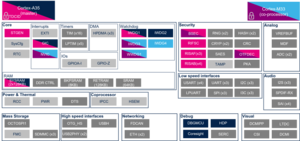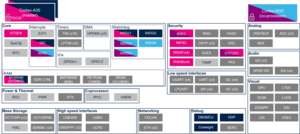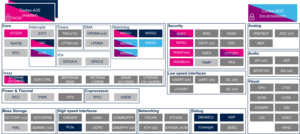1. Article purpose[edit | edit source]
The purpose of this article is to:
- briefly introduce the RIFSC peripheral and its main features,
- indicate the peripheral instances assignment at boot time and their assignment at runtime (including whether instances can be allocated to secure contexts),
- list the software frameworks and drivers managing the peripheral,
- explain how to configure the peripheral.
2. Peripheral overview[edit | edit source]
The RIFSC (RIF Security Controller) peripheral is the control interface of the RIF (Resource Isolation Framework). It provides configuration registers to:
- define access right (CID, secure, and privilege level) for each peripheral protected by a RISUP
- define initiator peripheral bus behavior by setting CID, secure, and privilege level (RIMU)
- define low power RAM memory protection (RISAL)
- define JTAG DAP configuration
On STM32MP25x lines ![]() , there are:
, there are:
- RISUP blocks to protect the different instances of peripherals. RISUP default configuration is non-secure, unprivileged, and CID filtering disabled.
- 16 RIMU, one in front of each bus initiator peripheral (ETR, SDMMC1, SDMMC1, SDMMC3, USB3DR, USBH, ETH1, ETH2, PCIE, GPU, DCMIPP, LTDC rotation, LTDC layers 1/2, LTDC layer 3, VDEC, and VENC). By default, RIMU are set in non-secure, unprivileged, and CID inheritance from associated peripheral RISUP (except for ETR and LTDC for which inheritance is not possible).
- 3 RISAL to protect LPSRAM1, LPSRAM2, and LPSRAM3. By default, LPSRAM accesses are defined as non-secure, unprivileged, Cortex-M33®, and Cortex®-M0+.
On STM32MP23x lines ![]() , there are:
, there are:
- RISUP blocks to protect the different instances of peripherals. RISUP default configuration is non-secure, unprivileged, and CID filtering disabled.
- 15 RIMU, one in front of each bus initiator peripheral (ETR, SDMMC1, SDMMC1, SDMMC3, USB3DR, USBH, ETH1, ETH2, GPU, DCMIPP, LTDC layers 1/2, LTDC layer 3 and LTDC rotation and VDEC). By default, RIMU are set in non-secure, unprivileged, and CID inheritance from associated peripheral RISUP (except for ETR and LTDC for which inheritance is not possible).
On STM32MP21x lines ![]() , there are:
, there are:
- RISUP blocks to protect the different instances of peripherals. RISUP default configuration is non-secure, unprivileged, and CID filtering disabled.
- 11 RIMU, one in front of each bus initiator peripheral (ETR, SDMMC1, SDMMC1, SDMMC3, OTG_HS, USBH, ETH1, ETH2, LTDC layers 1/2 and LTDC layer 3). By default, RIMU are set in non-secure, unprivileged, and CID inheritance from associated peripheral RISUP (except for ETR and LTDC for which inheritance is not possible).
Main RIFSC configuration is under TDCID processor responsibility, but all execution contexts can read it. Moreover, it is possible to modify the RISUP configuration according to following rules:
- Only the TDCID execution context can modify the CID filtering configuration of this resource.
- A secure execution context owning a resource can modify the security level of this resource.
- A privilege execution context owning a resource can modify the privilege level of this resource.
The RIFSC configuration is preserved in low power mode.
Refer to the STM32 MPU reference manuals for the complete list of features and to the software frameworks and drivers introduced below to see which features are implemented.
3. Peripheral usage[edit | edit source]
This chapter is applicable in the scope of the OpenSTLinux BSP running on the Arm® Cortex®-A processor(s), and the FwST-M Package running on the Arm® Cortex®-M processor.
3.1. Boot time assignment[edit | edit source]
As soon as the STM32MP2 is powered up, the Cortex®-A35 starts to execute the ROM code, which configures and verifies the RIFSC configuration to ensure the isolation of its execution.
For the A35-TD flavor ![]() , it then executes the FSBL TF-A in secure mode, which can temporarily take ownership of some peripherals to be compliant with its execution model.
The SSBL U-Boot executed in non-secure mode accesses the RIFSC to verify if a resource can be accessed by Cortex®-A35 non-secure execution. If required, U-Boot can acquire the RIF semaphore associated with the resource to grant the access.
, it then executes the FSBL TF-A in secure mode, which can temporarily take ownership of some peripherals to be compliant with its execution model.
The SSBL U-Boot executed in non-secure mode accesses the RIFSC to verify if a resource can be accessed by Cortex®-A35 non-secure execution. If required, U-Boot can acquire the RIF semaphore associated with the resource to grant the access.
For the M33-TD flavor ![]() , the Cortex®-A35 stays in reset and the Cortex®-M33 then execute the FSBL MCUBoot, which can temporarily take ownership of some peripherals to be compliant with its execution model.
, the Cortex®-A35 stays in reset and the Cortex®-M33 then execute the FSBL MCUBoot, which can temporarily take ownership of some peripherals to be compliant with its execution model.
3.1.1. On STM32MP2 series[edit | edit source]
3.1.1.1. For A35-TD flavor  [edit | edit source]
[edit | edit source]
Click on ![]() to expand or collapse the legend...
to expand or collapse the legend...
Check boxes illustrate the possible peripheral allocations supported by the OpenSTLinux BSP:
- ⬚ means that the peripheral can be assigned to the given boot time context, but this configuration is not supported in OpenSTLinux BSP.
- ☐ means that the peripheral can be assigned to the given boot time context.
- ☑ means that the peripheral is assigned by default to the given boot time context and that the peripheral is mandatory for the OpenSTLinux BSP.
- ✓ is used for system peripherals that cannot be unchecked because they are hardware connected in the device.
The present chapter describes STMicroelectronics recommendations or choice of implementation. Additional possibilities might be described in STM32 MPU reference manuals.
| Domain | Peripheral | Boot time allocation | Comment | |||
|---|---|---|---|---|---|---|
| Instance | Cortex-A35 secure (ROM code) |
Cortex-A35 secure (TF-A BL2) |
Cortex-A35 nonsecure (U-Boot) | |||
| Security | RIFSC | RIFSC | ✓ | ☑ | ☑ | |
3.1.1.2. For M33-TD flavor  [edit | edit source]
[edit | edit source]
Click on ![]() to expand or collapse the legend...
to expand or collapse the legend...
Check boxes illustrate the possible peripheral allocations supported by the OpenSTLinux BSP:
- ⬚ means that the peripheral can be assigned to the given boot time context, but this configuration is not supported in OpenSTLinux BSP.
- ☐ means that the peripheral can be assigned to the given boot time context.
- ☑ means that the peripheral is assigned by default to the given boot time context and that the peripheral is mandatory for the OpenSTLinux BSP.
- ✓ is used for system peripherals that cannot be unchecked because they are hardware connected in the device.
The present chapter describes STMicroelectronics recommendations or choice of implementation. Additional possibilities might be described in STM32 MPU reference manuals.
| Domain | Peripheral | Boot time allocation | Comment | ||||
|---|---|---|---|---|---|---|---|
| Instance | Cortex-A35 secure (ROM code) |
Cortex-A35 secure (TF-A BL2) |
Cortex-A35 nonsecure (U-Boot) |
Cortex-M33 secure (MCUboot) | |||
| Security | RIFSC | RIFSC | ✓ | ☑ | ☑ | ☑ | |
3.2. Runtime assignment[edit | edit source]
For the A35-TD flavor ![]() , the Cortex®-A35 is the TDCID processor, which means Cortex®-A35 secure execution can completely configure the RISFC. In this mode, OP-TEE is in charge of the RIFSC configuration before the startup of any other execution context. This allows the selected peripherals to be assigned to the different hardware execution context of the platform before their execution.
, the Cortex®-A35 is the TDCID processor, which means Cortex®-A35 secure execution can completely configure the RISFC. In this mode, OP-TEE is in charge of the RIFSC configuration before the startup of any other execution context. This allows the selected peripherals to be assigned to the different hardware execution context of the platform before their execution.
For the M33-TD flavor ![]() , the Cortex®-M33 is the TDCID processor, which means Cortex®-M33 secure execution can completely configure the RISFC. In this mode, TF-M is in charge of the RIFSC configuration before the startup of any other execution context. This allows the selected peripherals to be assigned to the different hardware execution context of the platform before their execution.
, the Cortex®-M33 is the TDCID processor, which means Cortex®-M33 secure execution can completely configure the RISFC. In this mode, TF-M is in charge of the RIFSC configuration before the startup of any other execution context. This allows the selected peripherals to be assigned to the different hardware execution context of the platform before their execution.
The different execution contexts access the RIFSC at runtime to check if they can access a peripheral before trying to use it.
3.2.1. On STM32MP21x lines  [edit | edit source]
[edit | edit source]
The tables below are applicable to any TD flavor (A35-TD or M33-TD) ![]() .
.
Click on ![]() to expand or collapse the legend...
to expand or collapse the legend...
Check boxes illustrate the possible peripheral allocations supported by the OpenSTLinux BSP:
- ⬚ means that the peripheral can be assigned to the given runtime context, but this configuration is not supported in OpenSTLinux BSP.
- ☐ means that the peripheral can be assigned to the given runtime context.
- ☑ means that the peripheral is assigned by default to the given runtime context and that the peripheral is mandatory for the OpenSTLinux BSP.
- ✓ is used for system peripherals that cannot be unchecked because they are hardware connected in the device.
Refer to How to assign an internal peripheral to an execution context for more information on how to assign peripherals manually or via STM32CubeMX.
The present chapter describes STMicroelectronics recommendations or choice of implementation. Additional possibilities might be described in STM32MP21 reference manuals.
| Domain | Peripheral | Runtime allocation | Comment | ||||
|---|---|---|---|---|---|---|---|
| Instance | Cortex-A35 secure (OP-TEE / TF-A BL31) |
Cortex-A35 nonsecure (Linux) |
Cortex-M33 secure (TF-M) |
Cortex-M33 nonsecure (STM32Cube) | |||
| Security | RIFSC | RIFSC | ☑OP-TEE | ☑ | ☑ | ☐ | |
3.2.2. On STM32MP23x lines  [edit | edit source]
[edit | edit source]
The tables below are applicable to any TD flavor (A35-TD or M33-TD) ![]() .
.
Click on ![]() to expand or collapse the legend...
to expand or collapse the legend...
Check boxes illustrate the possible peripheral allocations supported by the OpenSTLinux BSP:
- ⬚ means that the peripheral can be assigned to the given runtime context, but this configuration is not supported in OpenSTLinux BSP.
- ☐ means that the peripheral can be assigned to the given runtime context.
- ☑ means that the peripheral is assigned by default to the given runtime context and that the peripheral is mandatory for the OpenSTLinux BSP.
- ✓ is used for system peripherals that cannot be unchecked because they are hardware connected in the device.
Refer to How to assign an internal peripheral to an execution context for more information on how to assign peripherals manually or via STM32CubeMX.
The present chapter describes STMicroelectronics recommendations or choice of implementation. Additional possibilities might be described in STM32MP23 reference manuals.
| Domain | Peripheral | Runtime allocation | Comment | ||||
|---|---|---|---|---|---|---|---|
| Instance | Cortex-A35 secure (OP-TEE / TF-A BL31) |
Cortex-A35 nonsecure (Linux) |
Cortex-M33 secure (TF-M) |
Cortex-M33 nonsecure (STM32Cube) | |||
| Security | RIFSC | RIFSC | ☑OP-TEE | ☑ | ☑ | ☐ | |
3.2.3. On STM32MP25x lines  [edit | edit source]
[edit | edit source]
The tables below are applicable to any TD flavor (A35-TD or M33-TD) ![]() .
.
Click on ![]() to expand or collapse the legend...
to expand or collapse the legend...
Check boxes illustrate the possible peripheral allocations supported by the OpenSTLinux BSP:
- ⬚ means that the peripheral can be assigned to the given runtime context, but this configuration is not supported in OpenSTLinux BSP.
- ☐ means that the peripheral can be assigned to the given runtime context.
- ☑ means that the peripheral is assigned by default to the given runtime context and that the peripheral is mandatory for the OpenSTLinux BSP.
- ✓ is used for system peripherals that cannot be unchecked because they are hardware connected in the device.
Refer to How to assign an internal peripheral to an execution context for more information on how to assign peripherals manually or via STM32CubeMX.
The present chapter describes STMicroelectronics recommendations or choice of implementation. Additional possibilities might be described in STM32MP25 reference manuals.
| Domain | Peripheral | Runtime allocation | Comment | |||||
|---|---|---|---|---|---|---|---|---|
| Instance | Cortex-A35 secure (OP-TEE / TF-A BL31) |
Cortex-A35 nonsecure (Linux) |
Cortex-M33 secure (TF-M) |
Cortex-M33 nonsecure (STM32Cube) |
Cortex-M0+ (STM32Cube) | |||
| Security | RIFSC | RIFSC | ☑OP-TEE | ☑ | ☑ | ☐ | ||
4. Software frameworks and drivers[edit | edit source]
Below are listed the software frameworks and drivers managing the RIFSC peripheral for the embedded software components listed in the above tables.
- Linux®:
- U-Boot:
- OP-TEE:
- TF-A:
- TF-M:
5. How to assign and configure the peripheral[edit | edit source]
The peripheral assignment can be done via the STM32CubeMX graphical tool (and manually completed if needed).
According to the selected assignment, STM32CubeMX is generating the RIFSC device tree configuration that the secure OS running on the TDCID processor will program.
This tool also helps to enable the peripheral support in the different software components by generating:
- partial device trees enabling the selected peripherals for the OpenSTLinux software components,
- HAL initialization code for the STM32CubeMPU Package for the selected peripherals.
6. References[edit | edit source]


